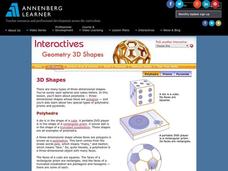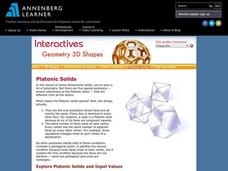Annenberg Foundation
Geometry 3D Shapes: 3D Shapes
Explore vocabulary related to three-dimensional shapes. An instructional website describes the characteristics of different geometric solids. Learners can use an interactive component to view nets, faces, vertices, and edges of common...
Annenberg Foundation
Geometry 3D Shapes: Platonic Solids
From polyhedrons to platonic solids, here is a lesson that will have your classes talking! As an introduction to platonic solids, scholars cut and fold nets to create the three-dimensional solids. They use an interactive component to...
Annenberg Foundation
Geometry 3D Shapes: Euler's Theorem
How do you get a theorem named after you? Euler knows what it takes! The third lesson of five asks pupils to use an interactive activity to compare the faces, vertices, and edges of seven different three-dimensional solids. They use...
American Museum of Natural History
Meet the Universe's Main Attraction ... Gravity
Learners read a short description about gravity and what it does and then explore the two ideas about how gravity works. After gaining a better understanding of the concept, individuals participate in a thorough experiment on what would...
Primary Resources
Primary Resources: 2 D and 3 D Shapes
Here is a huge collection of teacher resources for teaching 2-D and 3-D shapes. Includes smartboard and PowerPoint presentations, as well as worksheets and helpful hints.
PBS
Pbs Learning Media: Ready to Learn 2010 2015 Initiative (Pbs Kids Lab)
PBS KIDS Lab is built on the belief that every new technology is a learning opportunity. This page includes links to PBS programming, apps, games, videos, activities, and education resources. Teaching Tips provide step-by-step lessons...
PBS
Pbs Learning Media: Making Rock Candy
In this video segment from Cyberchase, two friends make rock candy while learning about 2-D and 3-D shapes.
University of Regina (Canada)
University of Regina: Math Central: Lesson: Mr. Z's 5 Minute Game of Geometric Pandemonium
Students make a series of geometric drawings of points, obtuse angles, rays, polygons, and the like. Each child is given one but not allowed to show anyone else. The drawing is then taped to the back of the child in front of them. The...
Other popular searches
- 3 D and 2 D Shapes
- Sorting 2 D Shapes
- Geometric 2 D Shapes
- Classifying 2 D Shapes
- 2 D Shapes and Attributes
- Area of 2 D Shapes
- Transform 2 D Shapes
- Maths 2 D Shapes
- Classifying 2 D Shapes
- 2 D Shapes and Patterns
- Drawing 2 D Shapes
- Area/perimeter 2 D Shapes






